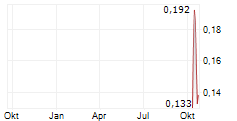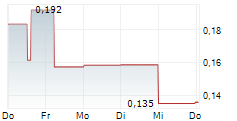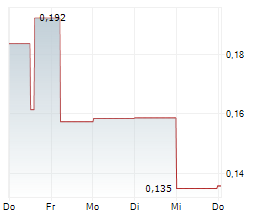Toronto, Ontario--(Newsfile Corp. - August 26, 2025) - Kirkland Lake Discoveries (TSXV: KLDC) (OTCID: KLKLF) ("KLDC" or the "Company") is pleased to report that recent drilling at the KL West Property has expanded the mineralized system, with three additional holes intersecting semi-massive to massive sulphides. The results confirm the role of the Winnie Pluton as a key driver of mineralization and represent a significant advance in the Company's intrusive-related exploration model across a district-scale land position.
- Three additional holes near KLD25-28 (see August 12 news release) cut broad zones of alteration with disseminated sulphides haloing semi-massive to massive sulphide mineralization.
- KLD25-37 intersected mineralization at 97.5 m downhole, demonstrating the system's continuity at depth.
- All 1,011 samples from the program have been submitted for assay and are pending.
- Drilling validates the Winnie Pluton's role as a key driver of mineralization, further supporting KLDC's intrusive-related model.
Management Commentary:
"The consistency of alteration patterns and sulphide mineralization styles across multiple holes has validated our intrusive-related model and demonstrated the robust nature of this system. What we're observing represents a significant departure from the limited historical interpretation. The geological evidence indicates the Winnie Shaft historically captured only the uppermost expression of a much larger intrusive-driven system. The systematic alteration halos, multiple mineralization styles, and depth continuity we've intersected are characteristic of the major intrusive-related deposits that have defined production in the Abitibi. With our 40,000-hectare land position encompassing the entire 17-kilometer Winnie Pluton contact, we have established a substantial exploration target with the geological characteristics consistent with district-scale mineralizing systems." - Stefan Sklepowicz, CEO.
A New Interpretation: Targeting an Intrusive System
The program was designed to test a new geological model around the historical Winnie Shaft, an area previously known for copper, zinc, silver, and gold. The shaft itself only reached ~20 feet and was originally explored as a volcanogenic massive sulphide (VMS).
KLDC's technical team now believes the mineralization is more likely part of an intrusive-related system, with heat and fluids from the Winnie Pluton driving mineral deposition (see Figure 1). Unlike layered seafloor-style VMS deposits, intrusive systems typically form extensive, cohesive zones of mineralization that extend to significant depths and across wide contact zones. This program represents the first test of this model.
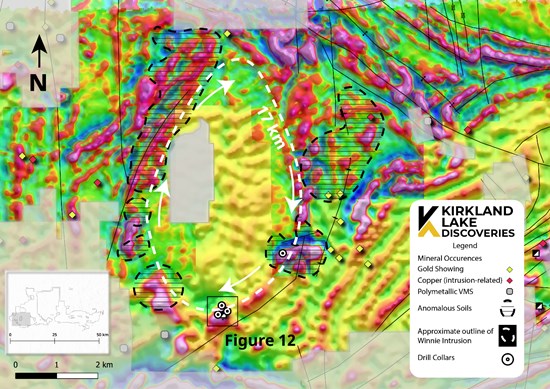
Figure 1 - Regional magnetic survey map (1VD) outlining the approximate 17-km perimeter of the Winnie Intrusion. Magnetic highs (red/purple) correspond to areas of interest along the intrusion contact, where gold, copper (intrusion-related) and polymetallic VMS occurrences are documented. Anomalous soil results further highlight high-priority targets along the intrusion margin.
To view an enhanced version of this graphic, please visit:
https://images.newsfilecorp.com/files/5701/263889_14be770894965a14_001full.jpg
Drill Program Observations
- The program consisted of 10 drill holes totalling 1,722 m (see Table 1), with 1,011 samples (including QA/QC blanks and standards) submitted to MSA Labs in Timmins.
- Multiple holes intersected semi-massive to massive sulphides near the Winnie Shaft, associated with alteration halos and intrusive contacts, supporting the new model.
- Multiple mineralization styles were core-logged, indicating a robust mineralizing system with several pulses of fluid activity.
- Combined with prior surficial sampling (which returned elevated bismuth - see July 9 and July 24 news releases), evidence points to a large intrusive-related system.
District-Scale Context and Exploration Advancement
The Kirkland Lake district has produced over 40 million ounces of gold, with major deposits typically associated with intrusive-related systems and regional structural controls. KLDC's 40,000-hectare land position represents the largest consolidated package in the district's history, encompassing the complete 17-km Winnie Pluton contact zone.
The Company will expand its dataset with advanced geophysics and geochemistry to define the most prospective targets across this contact zone. A Heli-MT survey planned for the fall will provide high-resolution imaging of intrusive contacts at depths of up to one kilometre. The 1,011 samples currently at the laboratory will provide both mineralization grade information and geochemical signatures to help vector towards the heart of the system (or towards the system's highest-grade zones).
These results will feed directly into the design of the KLDC's next phase of drilling, planned to aggressively test the most promising targets at depth and along strike as the system continues to open up.
Important Note on Visual Data:
The Company cautions that visual identification and estimates of sulphide mineralization are not a substitute for quantitative laboratory assays. While the presence of certain minerals is encouraging, only analytical lab results can determine the grade of copper, zinc, silver, and gold.
Summary of Visual Drill Core Logging - Winnie Lake Project (Assays Pending)
KLD25-28
The hole intersected multiple zones of strong mineralization. From 15-23 m, a silicified basalt with disseminated sulphides was logged. A 2.4-m interval of semi-massive to massive sulphides followed, with pyrite, chalcopyrite, and sphalerite. Additional massive sulphides were encountered at 39-40 m, again associated with silicified basalts. The hole also intersected brecciated basalt and syenite contacts deeper downhole, confirming a complex, mineralized environment.
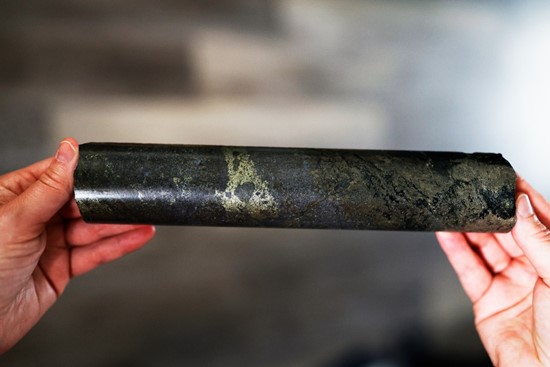
Figure 21 - KLD25-28 from 25 m - semi-massive to massive pyrite, chalcopyrite and silicified basalt.
To view an enhanced version of this graphic, please visit:
https://images.newsfilecorp.com/files/5701/263889_kirkland%20figure%202.jpg
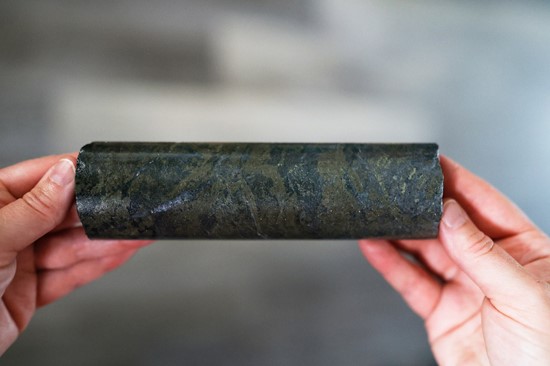
Figure 31 - KLD25-28 from 40 m - massive pyrite, chalcopyrite and sphalerite.
To view an enhanced version of this graphic, please visit:
https://images.newsfilecorp.com/files/5701/263889_kirkland%20figure%203.jpg
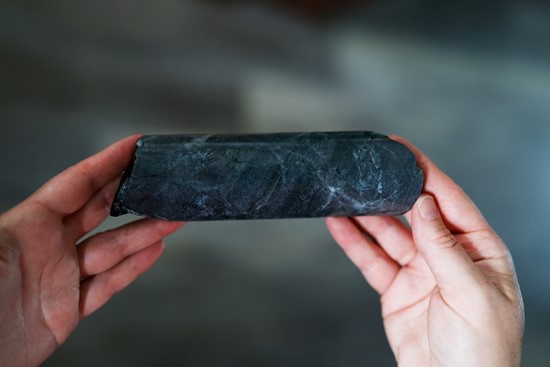
Figure 41 - KLD25-28 from 44 m - strongly silicified and mineralized basalt with very fine disseminated pyrite/chalcopyrite.
To view an enhanced version of this graphic, please visit:
https://images.newsfilecorp.com/files/5701/263889_kirkland%20figure%204.jpg
KLD25-29
Drilling targeted the contact between Winnie Shaft and Mini Winnie. The hole was dominated by mafic syenite, strongly magnetic and massive, interlayered with minor mafic volcanics. No significant sulphide zones were logged, but the contact relationship is geologically important for outlining the geometry.
KLD25-30
This hole was drilled northeast of KLD25-29, cutting through mafic volcanics and syenite intrusives. The volcanics were strongly magnetic in places, and intervals of porphyritic syenite contained quartz veining. No massive sulphide intervals were observed, but the geology confirms the intrusive-volcanic relationship across the target area.
KLD25-31
Targeting a magnetic low within syenite, this hole intersected long runs of massive hornblende syenite with strong magnetism (3-101 m and 103-265 m). While no massive sulphides were encountered, the presence of brecciation and some veining with disseminated sulphides is encouraging.
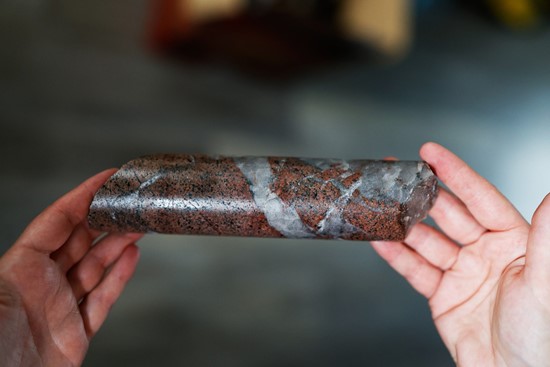
Figure 51 - KLD25-31 from 19 m - massive hornblende syenite with brecciated smoky quartz veins.
To view an enhanced version of this graphic, please visit:
https://images.newsfilecorp.com/files/5701/263889_kirkland%20figure%205.jpg
KLD25-32
This hole was dominated by syenite - feldspar porphyry. Alteration included potassic-hematite zones and occasional intervals of weak mineralization. Although sulphide content was limited, the style of alteration is consistent with fertile intrusive systems.
KLD25-33
Drilling at a gabbro/intrusive contact at surface, this hole intersected syenite - feldspar porphyry with weak to moderate alteration. No significant sulphides were observed, but the contact geology provides structural and lithological context for future drilling.
KLD25-34
After shallow overburden (13.5 m), drilling cut a zone of massive sulphides between 18-20 m, dominated by pyrite and chalcopyrite. Another semi-massive to massive sulphide interval was intersected at 35-36 m. Surrounding mafic volcanics were often silicified, with evidence of syenite dykes and brecciation. This hole demonstrates the presence of shallow, high-sulphide zones within the shaft area.
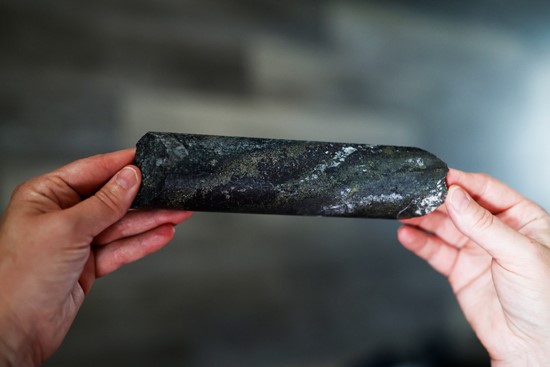
Figure 61 - KLD25-34 from 18.5 m - semi-massive to massive sphalerite rimmed with pyrite/chalcopyrite quartz carbonate veinlets and massive clots of magnetite.
To view an enhanced version of this graphic, please visit:
https://images.newsfilecorp.com/files/5701/263889_kirkland%20figure%206.jpg
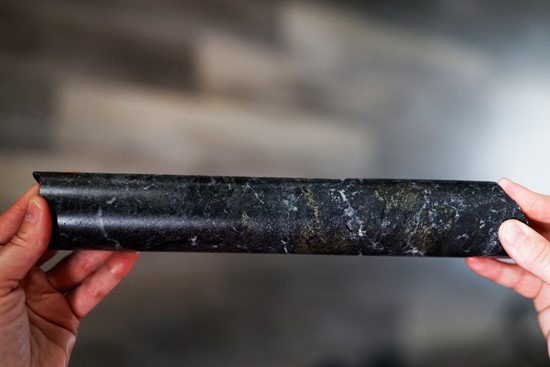
Figure 71 - KLD25-34 from 23.25m - interval of silicified mafic volcanics with pyrite, chalcopyrite and quartz carbonate veins within an intrusive syenite dyke.
To view an enhanced version of this graphic, please visit:
https://images.newsfilecorp.com/files/5701/263889_kirkland%20figure%207.jpg
KLD25-35
Multiple intervals of semi-massive to massive sulphides were logged, including 14.6-17 m and 18.3-19.6 m. Mineralization consisted of pyrite, chalcopyrite, and associated magnetite. Syenite intervals showed brecciation, silicification, and potassic-hematite alteration, reinforcing the presence of a mineralized intrusive-volcanic system.
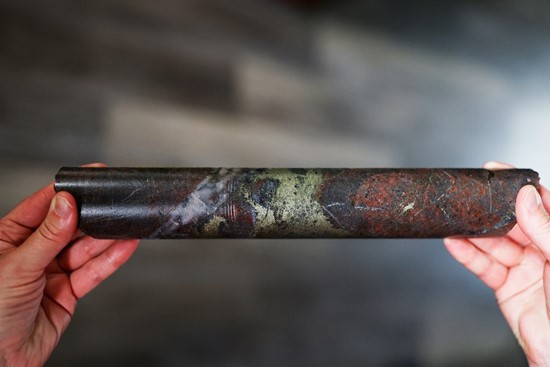
Figure 81 - KLD25-35 from 40.10 m - a raft of mafic volcanics with pervasive chalcopyrite within a highly altered syenite with chalcopyrite.
To view an enhanced version of this graphic, please visit:
https://images.newsfilecorp.com/files/5701/263889_kirkland%20figure%208.jpg
KLD25-36
This hole returned several short zones of semi-massive to massive sulphides, including 21.75-22 m, 24.2-24.7 m and 25.2-26.0 m, dominated by pyrite. Surrounding mafic volcanics were strongly silicified and chloritic, with a syenite dyke observed at 26 m. The repeated association of sulphides with intrusive contacts is highly encouraging.
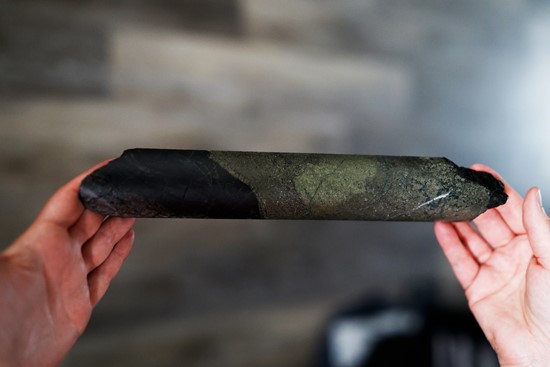
Figure 91 - KLD25-36 from 21.75 m - massive magnetite, pyrite and chalcopyrite.
To view an enhanced version of this graphic, please visit:
https://images.newsfilecorp.com/files/5701/263889_kirkland%20figure%209.jpg
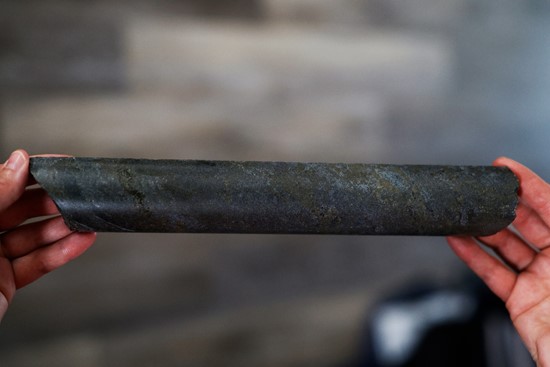
Figure 101 - KLD25-36 from 25.8 m - semi-massive to massive pyrite with chalcopyrite.
To view an enhanced version of this graphic, please visit:
https://images.newsfilecorp.com/files/5701/263889_kirkland%20figure%2010.jpg
KLD25-37
Testing deeper away from the Winnie Shaft, the hole intersected mafic volcanics interleaved with syenite and granodiorite. While no thick sulphide intervals were observed, alteration included potassic-hematite zones and magnetic volcanics, confirming a complex intrusive-volcanic environment. The hole ended in what appears to be a pillowed basalt with chalcopyrite and pyrite disseminations in fractures from 97.5-102 m, confirming mineralization continues at depth.
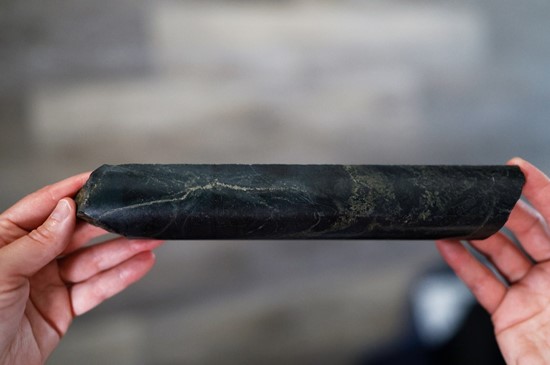
Figure 111 - KLD25-37 from 101 m - wispy, blebby and disseminated pyrite-chalcopyrite within mafic volcanics at end of hole.
To view an enhanced version of this graphic, please visit:
https://images.newsfilecorp.com/files/5701/263889_kirkland%20figure%2011.jpg
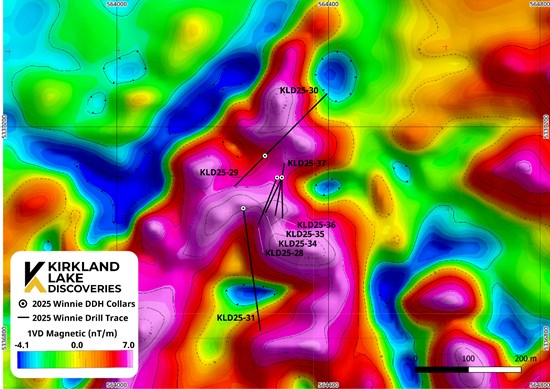
Figure 12 - 2025 drill collar locations and traces with 1VD high resolution drone magnetic survey background.
To view an enhanced version of this graphic, please visit:
https://images.newsfilecorp.com/files/5701/263889_14be770894965a14_012full.jpg
Table 1 - Drill hole locations, direction, inclination and meterage for summer 2025 drill program.
| Drill Hole # | Easting | Northing | Azimuth | Inclination | Total Length (m) |
| KLD25-28 | 564303 | 5337104 | 201º | -45º | 132 |
| KLD25-29 | 564280 | 5337145 | 225º | -45º | 114 |
| KLD25-30 | 564280 | 5337145 | 045º | -45º | 234 |
| KLD25-31 | 564239 | 5337046 | 172º | -45º | 330 |
| KLD25-32 | 565754 | 5338629 | 300º | -45º | 381 |
| KLD25-33 | 565754 | 5338629 | 045º | -45º | 117 |
| KLD25-34 | 564312 | 5337104 | 190º | -45º | 102 |
| KLD25-35 | 564312 | 5337104 | 205º | -45º | 102 |
| KLD25-36 | 564312 | 5337104 | 179º | -45º | 108 |
| KLD25-37 | 564312 | 5337104 | 010º | -75º | 102 |
| Program Total: | 1,722 | ||||
Geological Significance
The intersection of intrusion-related polymetallic mineralization at KL West is a significant breakthrough for the Kirkland Lake camp and the Company's landholdings. The 17-km perimeter of the Winnie Pluton, combined with the deposit model, presents strong potential for additional discoveries of this nature. Encountering a system with this combination of intrusive rocks, alteration, and mineralization in the Company's first drill program testing the Winnie Pluton, is a major technical success and positions KLDC well, with the district land package it holds.
Within the Blake River Group of rocks, intrusion-related deposits display similar mineralization and alteration as to what has been observed in the initial drill program at KL West. Some of the most significant production centers and recent discoveries in the Abitibi are found within the Blake River Group including La Ronde, Horne and Upper Beaver.
Video Footage
The latest episode of KLDC's Treasure Hunters YouTube series features video of the core and discussions with Senior Geologist Mike Kilbourne and CEO Stefan Sklepowicz.
Watch here:
Cannot view this video? Visit:
https://www.youtube.com/watch?v=r3Xctm5DCJk
QP Statement
The technical information contained in this news release has been approved by Mike Kilbourne, P.Geo., Senior geologist and independent contractor, who is a Qualified Person as defined in National Instrument 43-101, Standards of Disclosure for Mineral Projects.
About Kirkland Lake Discoveries Corp.
Kirkland Lake Discoveries Corp. (TSXV: KLDC) has assembled a 400-km2 exploration portfolio in the Kirkland Lake region of Ontario's Abitibi Greenstone Belt, one of the most prolific mining districts in the world. The Company's properties span key fault zones, geophysical anomalies, and volcanic-sedimentary contacts within the Blake River Group, a highly prospective assemblage known to host both gold and polymetallic VMS deposits.
With exploration permits now in place, KLDC is positioned to advance a strong pipeline of drill-ready targets at KL East and KL West, supported by multiple anomalous soil trends, historical mineral showings, and structurally controlled intersections. The team combines strong technical experience with a focus on smart, efficient exploration designed to deliver results.
For additional information, please contact:
Stefan Sklepowicz
Chief Executive Officer
www.kirklandlakediscoveries.com
+1 226 979 3515
stefan@kirklandlakediscoveries.com
Neither TSX Venture Exchange nor its Regulation Services Provider (as that term is defined in policies of the TSX Venture Exchange) accepts responsibility for the adequacy or accuracy of this release.
Forward-Looking Statements
Mineralization hosted on adjacent and/or nearby properties is not necessarily indicative of mineralization hosted on the Company's property. This news release contains certain "forward-looking information" and "forward-looking statements" (collectively "forward-looking statements") within the meaning of applicable securities legislation. All statements, other than statements of historical fact, included herein, without limitation, statements relating the future operations and activities of Kirkland Lake Discoveries, are forward-looking statements. Forward-looking statements are frequently, but not always, identified by words such as "expects", "anticipates", "believes", "intends", "estimates", "potential", "possible", and similar expressions, or statements that events, conditions, or results "will", "may", "could", or "should" occur or be achieved. Forward-looking statements in this news release relate to, among other things, the Company's drill program, the results thereof, and any impact therefrom. There can be no assurance that such statements will prove to be accurate, and actual results and future events could differ materially from those anticipated in such statements. Forward-looking statements reflect the beliefs, opinions and projections on the date the statements are made and are based upon a number of assumptions and estimates that, while considered reasonable by Kirkland Lake Discoveries, are inherently subject to significant business, economic, competitive, political and social uncertainties and contingencies. Many factors, both known and unknown, could cause actual results, performance or achievements to be materially different from the results, performance or achievements that are or may be expressed or implied by such forward-looking statements and the parties have made assumptions and estimates based on or related to many of these factors. Such factors include, without limitation, the ability to complete proposed exploration work, the results of exploration, continued availability of capital, changes in general economic, market and business conditions, and the ability to obtain any requisite approvals. Readers should not place undue reliance on the forward-looking statements and information contained in this news release concerning these items. Kirkland Lake Discoveries does not assume any obligation to update the forward-looking statements of beliefs, opinions, projections, or other factors, should they change, except as required by applicable securities laws.
1Examples of drill core photos are included to show the different styles of lithology, alteration, and mineralization, and are not necessarily representative of the entire length of specific intervals discussed within this release.

To view the source version of this press release, please visit https://www.newsfilecorp.com/release/263889
SOURCE: Kirkland Lake Discoveries Corp.
